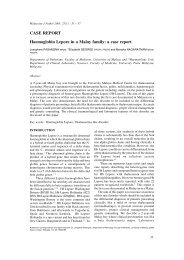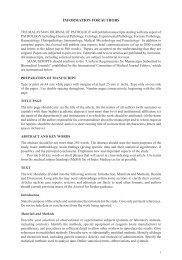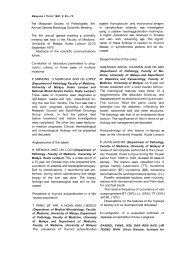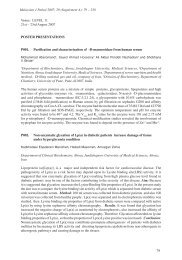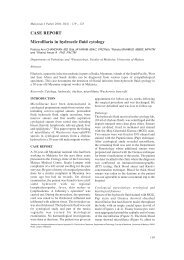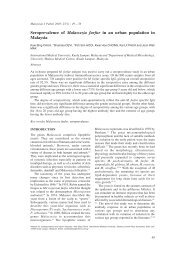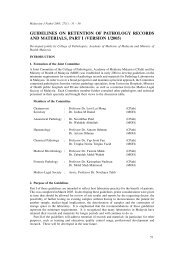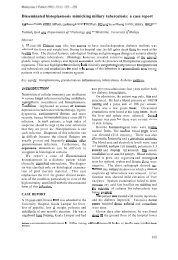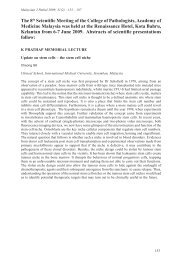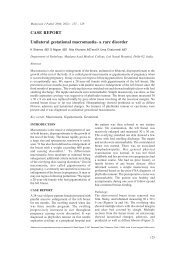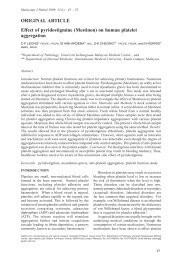Chediak-Higashi syndrome: a case report - MJPath
Chediak-Higashi syndrome: a case report - MJPath
Chediak-Higashi syndrome: a case report - MJPath
You also want an ePaper? Increase the reach of your titles
YUMPU automatically turns print PDFs into web optimized ePapers that Google loves.
Malaysian J Pathol June 2004<br />
girls aged 9 and 2 years.<br />
On examination the infant appeared well<br />
nourished, was fair skinned (much lighter in<br />
colour than his other family members) with dark<br />
gray hair showing a silvery tint. He was noted to<br />
have bilateral horizontal nystagmus with a<br />
convergent squint. Generalised maculopapular<br />
rash was observed which resolved spontaneously<br />
during his hospital stay. There was no significant<br />
lymphadenopathy, however, hepatomegaly (7<br />
cm below the right subcostal margin) and<br />
splenomegaly (10 cm below the left subcostal<br />
margin) were noted. The cardiovascular,<br />
respiratory and nervous systems were normal.<br />
The relevant haematological findings on<br />
admission were a moderate anaemia<br />
(haemoglobin 84.8 g/L), mild leucopenia (white<br />
blood cell count 4.4 x 10 9 /L), and a significant<br />
thrombocytopenia (platelet count 10 x 10 9 /L).<br />
The coagulation screen showed a prolonged<br />
activated partial thromboplastin time of 47<br />
seconds (27 – 38 seconds) and a thrombin time<br />
of 25 seconds (16 – 19 seconds). Other significant<br />
laboratory findings were a raised serum<br />
triglyceride level of 6.3 mmol/L, a grossly<br />
increased serum ferritin of 3,232.0 µg/L and a<br />
low plasma fibrinogen of 1.9 g/L. Neutrophil<br />
phagocytic function was found to be low.<br />
The striking feature in the peripheral blood<br />
film was the presence of several abnormal giant<br />
granules in the neutrophils (Figure 1) and single<br />
large azurophilic granules in many lymphocytes<br />
and in a few monocytes (Figure 2).<br />
Bone marrow aspirate revealed<br />
normocellularity and adequate haemopoietic<br />
cells. Similar giant granules were noted in the<br />
granulocytes and in many of the intermediate<br />
precursors of the granulocytic series. These<br />
granules were strongly myeloperoxidase positive<br />
(Figure 3). Some mononuclear cells had vacuoles<br />
in the cytoplasm (Figure 4). Admixed amongst<br />
the haemopoietic cells were some lymphocytes<br />
and histiocytes, a few of which showed<br />
haemophagocytosis.<br />
Serology for Ebstein Barr virus was positive<br />
for IgG but not for IgM. Parainfluenza virus 3<br />
was isolated from tracheal secretions. Serology<br />
for Toxoplasma, Rubella, Cytomegalovirus,<br />
Dengue and Herpes was negative. Stool<br />
examination too was negative for rota virus,<br />
Salmonella and Shigella. Blood cultures proved<br />
to be negative.<br />
Clinical course<br />
During his hospital stay, the patient had one<br />
episode of croup which was attributed to the<br />
FIG. 1: Neutrophil with abnormal giant granules in<br />
the cytoplasm. MGG x 40<br />
FIG. 2: Monocyte with a single large granule in<br />
cytoplasm. MGG x 40<br />
FIG. 3: Myelocytes with abnormal granules showing<br />
strong myeloperoxidase positivity. Peroxidase<br />
stain x 100<br />
positive culture of Parainfluenza virus 3 from<br />
his tracheal secretions. His persistent fever was<br />
treated with various antibiotics. Since the patient<br />
was diagnosed to be in the accelerated phase at<br />
presentation, he was given dexamethasone and<br />
54<br />
01 Hepatitis B(combined) 54<br />
20/5/05, 10:45 am




